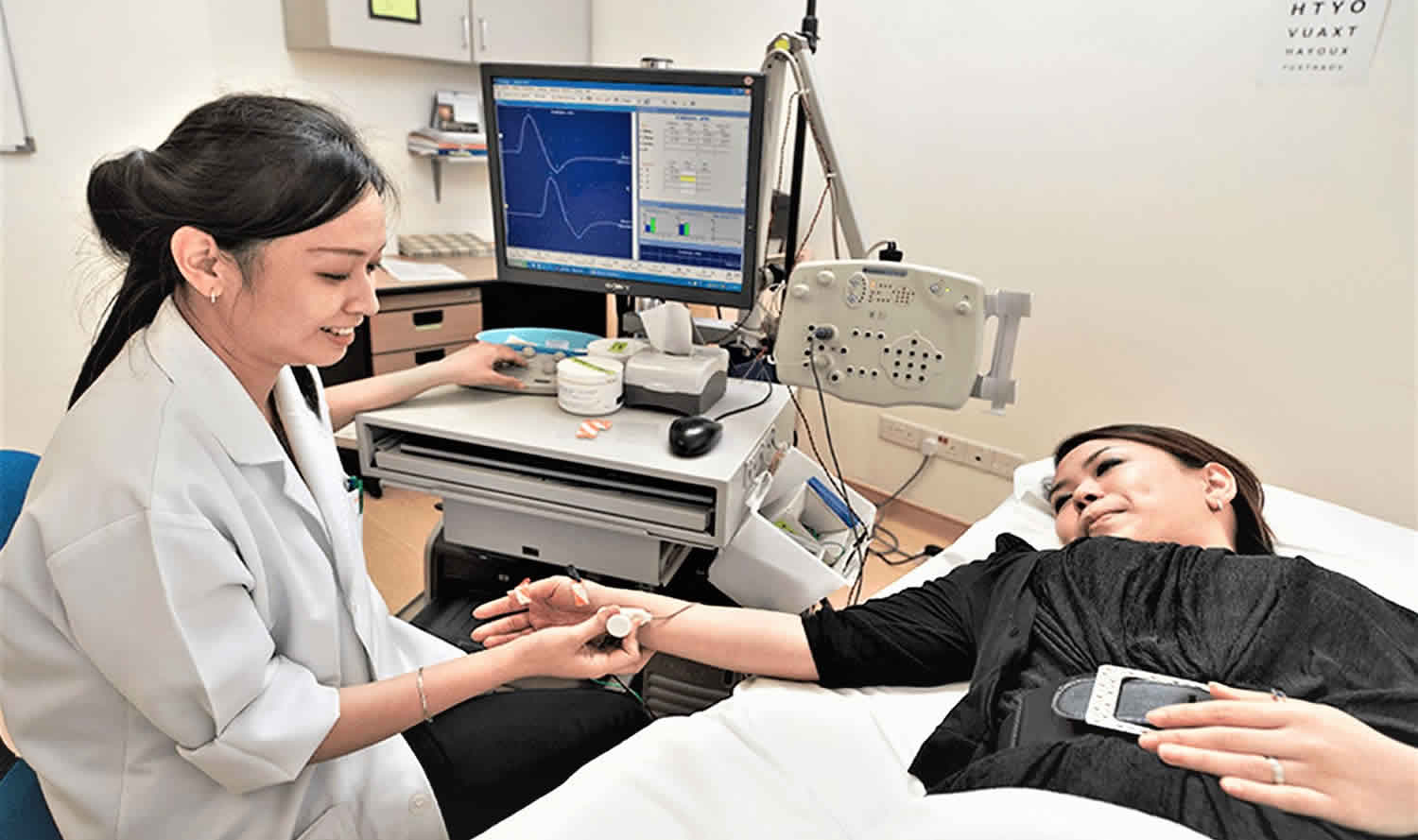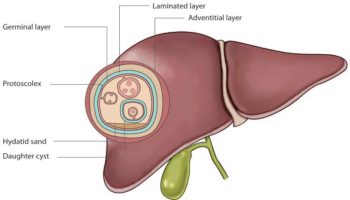Contents
What is electromyography
Electromyography (EMG) is a test that checks the health of your muscles and the nerves (motor neurons) that control your muscles. Electromyography results can reveal nerve dysfunction, muscle dysfunction or problems with nerve-to-muscle signal transmission.
Motor neurons (motor nerves) transmit electrical signals that cause muscles to contract. An electromyography uses tiny devices called electrodes to translate these signals into graphs, sounds or numerical values that are then interpreted by a specialist.
During an electromyography, your health care provider inserts a very thin needle electrode through the skin into the muscle. The electrode on the needle picks up the electrical activity given off by your muscles. This activity appears on a nearby monitor and may be heard through a speaker.
After placement of the electrodes, you may be asked to contract the muscle. For example, by bending your arm. The electrical activity seen on the monitor provides information about your muscle’s ability to respond when the nerves to your muscles are stimulated.
A nerve conduction velocity test, another part of an electromyography, is almost always performed during the same visit as an electromyography. A nerve conduction study uses electrode stickers applied to the skin (surface electrodes) to measure the speed and strength of signals traveling between two or more points.
Electromyography is most often used when a person has symptoms of weakness, pain, or abnormal sensation. It can help tell the difference between muscle weakness caused by the injury of a nerve attached to a muscle, and weakness due to nervous system disorders, such as muscle diseases.
How the electromyography test feel?
You may feel some pain or discomfort when the needles are inserted. But most people are able to complete the test without problems.
Afterward, the muscle may feel tender or bruised for a few days.
Why is electromyography test done?
Your doctor may order a electromyography test if you have signs or symptoms that may indicate a nerve or muscle disorder. Such symptoms may include:
- Tingling
- Numbness
- Muscle weakness
- Muscle pain or cramping
- Certain types of limb pain
Electromyography test results are often necessary to help diagnose or rule out a number of conditions such as:
- Muscle disorders, such as muscular dystrophy or polymyositis
- Diseases affecting the connection between the nerve and the muscle, such as myasthenia gravis
- Disorders of nerves outside the spinal cord (peripheral nerves), such as carpal tunnel syndrome or peripheral neuropathies
- Disorders that affect the motor neurons in the brain or spinal cord, such as amyotrophic lateral sclerosis or polio
- Disorders that affect the nerve root, such as a herniated disk in the spine
Electromyography procedure
Electromyography prep
Food and medications
When you schedule your electromyography, ask if you need to stop taking any prescription or over-the-counter medications before the exam. If you are taking a medication called Mestinon (pyridostigmine), you should specifically ask if this medication should be discontinued for the examination.
Bathing
Take a shower or bath shortly before your exam in order to remove oils from your skin. Don’t apply lotions or creams before the exam.
Other precautions
The nervous system specialist (neurologist) conducting the electromyography will need to know if you have certain medical conditions. Tell the neurologist and other electromyography lab personnel if you:
- Have a pacemaker or any other electrical medical device
- Take blood-thinning medications
- Have hemophilia, a blood-clotting disorder that causes prolonged bleeding
Body temperature can affect the results of this test. If it is extremely cold outside, you may be told to wait in a warm room for a while before the test is performed.
During the electromyography procedure
You’ll likely be asked to change into a hospital gown for the electromyography procedure and lie down on an examination table. To prepare for the electromyography study, the neurologist or a technician places surface electrodes at various locations on your skin depending on where you’re experiencing symptoms. Or the neurologist may insert needle electrodes at different sites depending on your symptoms.
When the study is underway, the surface electrodes will at times transmit a tiny electrical current that you may feel as a twinge or spasm. The needle electrode may cause discomfort or pain that usually ends shortly after the needle is removed.
During the needle electromyography, the neurologist will assess whether there is any spontaneous electrical activity when the muscle is at rest — activity that isn’t present in healthy muscle tissue — and the degree of activity when you slightly contract the muscle.
He or she will give you instructions on resting and contracting a muscle at appropriate times. Depending on what muscles and nerves the neurologist is examining, he or she may ask you to change positions during the exam.
If you’re concerned about discomfort or pain at any time during the exam, you may want to talk to the neurologist about taking a short break.
A nerve conduction velocity test is almost always performed during the same visit as an electromyography test. The velocity test is done to see how fast electrical signals move through a nerve.
After the electromyography procedure
You may experience some temporary, minor bruising where the needle electrode was inserted into your muscle. This bruising should fade within several days. If it persists, contact your primary care doctor.
Electromyography test results
The neurologist will interpret the results of your exam and prepare a report. Your primary care doctor, or the doctor who ordered the electromyography, will discuss the report with you at a follow-up appointment.
Normal Results
There is normally very little electrical activity in a muscle while at rest. Inserting the needles can cause some electrical activity, but once the muscles quiet down, there should be little electrical activity detected.
When you flex a muscle, activity begins to appear. As you contract your muscle more, the electrical activity increases and a pattern can be seen. This pattern helps your doctor determine if the muscle is responding as it should.
What Abnormal Results Mean
An electromyography test can detect problems with your muscles during rest or activity. Disorders or conditions that cause abnormal results include the following:
- Alcoholic neuropathy (damage to nerves from drinking too much alcohol)
- Amyotrophic lateral sclerosis (ALS; disease of the nerve cells in the brain and spinal cord that control muscle movement)
- Axillary nerve dysfunction (damage of the nerve that controls shoulder movement and sensation)
- Becker muscular dystrophy (muscle weakness of the legs and pelvis)
- Brachial plexopathy (problem affecting the set of nerves that leave the neck and enter the arm)
- Carpal tunnel syndrome (problem affecting the median nerve in the wrist and hand)
- Cubital tunnel syndrome (problem affecting the ulnar nerve in the elbow)
- Cervical spondylosis (neck pain from wear on the disks and bones of the neck)
- Common peroneal nerve dysfunction (damage of the peroneal nerve leading to loss of movement or sensation in the foot and leg)
- Denervation (reduced nerve stimulation of a muscle)
- Dermatomyositis (muscle disease that involves inflammation and a skin rash)
- Distal median nerve dysfunction (problem affecting the median nerve in the arm)
- Duchenne muscular dystrophy (inherited disease that involves muscle weakness)
- Facioscapulohumeral muscular dystrophy (Landouzy-Dejerine; disease of muscle weakness and loss of muscle tissue)
- Familial periodic paralysis (disorder that causes muscle weakness and sometimes a lower than normal level of potassium in the blood)
- Femoral nerve dysfunction (loss of movement or sensation in parts of the legs due to damage to the femoral nerve)
- Friedreich ataxia (inherited disease that affects areas in the brain and spinal cord that control coordination, muscle movement, and other functions)
- Guillain-Barré syndrome (autoimmune disorder of the nerves that leads to muscle weakness or paralysis)
- Lambert-Eaton syndrome (autoimmune disorder of the nerves that causes muscle weakness)
- Multiple mononeuropathy (a nervous system disorder that involves damage to at least 2 separate nerve areas)
- Mononeuropathy (damage to a single nerve that results in loss of movement, sensation, or other function of that nerve)
- Myopathy (muscle degeneration caused by a number of disorders, including muscular dystrophy)
- Myasthenia gravis (autoimmune disorder of the nerves that causes weakness of the voluntary muscles)
- Peripheral neuropathy (damage of nerves away from the brain and spinal cord)
- Polymyositis (muscle weakness, swelling, tenderness, and tissue damage of the skeletal muscles)
- Radial nerve dysfunction (damage of the radial nerve causing loss of movement or sensation in the back of the arm or hand)
- Sciatic nerve dysfunction (injury to or pressure on the sciatic nerve that causes weakness, numbness, or tingling in the leg)
- Sensorimotor polyneuropathy (condition that causes a decreased ability to move or feel because of nerve damage)
- Shy-Drager syndrome (nervous system disease that causes bodywide symptoms)
- Thyrotoxic periodic paralysis (muscle weakness from high levels of thyroid hormone)
- Tibial nerve dysfunction (damage of the tibial nerve causing loss of movement or sensation in the foot)
Electromyography side effects
Electromyography is a low-risk procedure, and complications are rare. There’s a small risk of bleeding, infection and nerve injury where a needle electrode is inserted.
When muscles along the chest wall are examined with a needle electrode, there’s a very small risk that it could cause air to leak into the area between the lungs and chest wall, causing a lung to collapse (pneumothorax).





